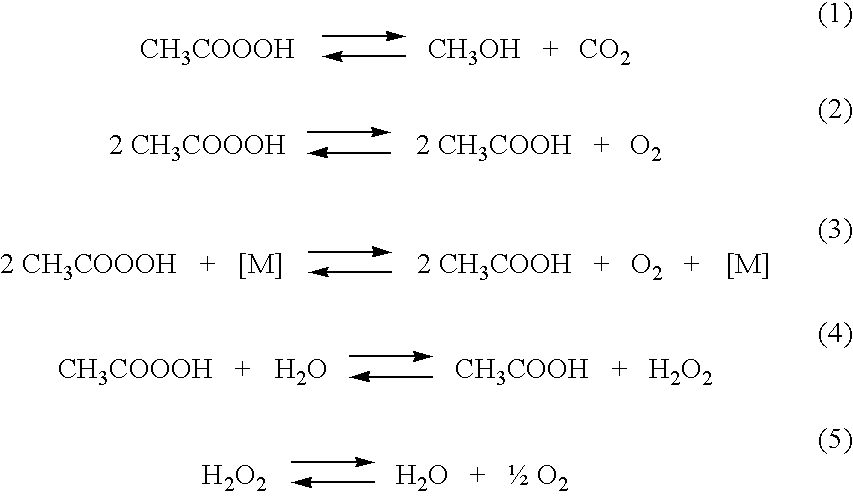Dilute Aqueous Peracid Solutions and Stabilization Method
a technology of aqueous peracid solutions and stabilization methods, which is applied in the field of dilute aqueous peracid solutions to achieve the effect of stabilizing the solution, reducing the risk of decomposition, and reducing the stability of the solution
- Summary
- Abstract
- Description
- Claims
- Application Information
AI Technical Summary
Benefits of technology
Problems solved by technology
Method used
Image
Examples
example 1
[0082]Example 1 is a laboratory-scale study in which three dilute aqueous peracetic acid solutions were prepared according to the method of this invention, with low stabilizer levels ranging from 0.05 wt % to 0.2 wt % stabilizer. Two samples of each of the three peracetic acid solutions were respectively evaluated for their long term stability while being maintained at constant storage temperatures of 25° C. and 50° C.
[0083]The aqueous peracetic acid solutions contained about 0.5-0.6 wt % peracetic acid, about 9 wt % hydrogen peroxide and about 5 wt % acetic acid, with three different concentration levels of a stabilizer. The stabilizer was a commercially-available stabilizer comprising 1-hydroxy ethylidene-1,1-diphosphonic acid, namely Dequest® 2010 stabilizer, which is marketed by Thermphos International B.V., Vlissingen-Oost, NL. The amounts of Dequest 2010 stabilizer in the aqueous peracetic acid solutions in the three studies were 0.05 wt %, 0.1 wt % and 0.2 wt % stabilizer, al...
example 2
[0098]Example 2 is a another laboratory-scale study in which three dilute aqueous peracetic acid solutions were prepared according to the method of this invention, with higher stabilizer levels ranging from 0.3 wt % to 0.9 wt % stabilizer, and separate samples were evaluated for their long term stability while being maintained at constant temperatures of 25° C. and 50° C.
[0099]The aqueous peracetic acid solutions contained about 0.7-0.8 wt % peracetic acid, about 9 wt % hydrogen peroxide and about 5 wt % acetic acid, with three different concentration levels of a stabilizer being used. The stabilizer in this Example 2 was Dequest 2010 stabilizer comprising 1-hydroxy ethylidene-1,1-diphosphonic acid, the same stabilizer used in Example 1. The aqueous peracetic acid solutions in the three studies, Examples 2A, 2B and 2C, respectively contained concentrations of Dequest® 2010 stabilizer of 0.3 wt %, 0.6 wt % and 0.9 wt % stabilizer, all percentages based on the total weight of the aque...
example 3
[0108]Example 3 is a laboratory-scale study in which two dilute aqueous peracetic acid solutions were prepared according to the method of this invention, containing 0.3 wt % stabilizer but with two levels of hydrogen peroxide, and separate samples were evaluated for their long term stability while being maintained at constant temperatures of 25° C. and 50° C.
[0109]The aqueous peracetic acid solutions in Examples 3A and 3B were prepared according to the general procedure described in Example 1. In addition, Examples 3A and 3B also contained sulfuric acid, introduced at a concentration of 0.24 wt % H2SO4. The compositions of the dilute peracetic acid solutions of Examples 3A and 3B were analyzed after their preparation for their peracetic acid, hydrogen peroxide and acetic acid concentrations, and these analyses are respectively shown in Tables 3A and 3B, in the first data row of each Table.
[0110]The stabilized dilute peracetic acid solution in Example 3A contained 0.65 wt % peracetic...
PUM
| Property | Measurement | Unit |
|---|---|---|
| temperature | aaaaa | aaaaa |
| temperature | aaaaa | aaaaa |
| wt % | aaaaa | aaaaa |
Abstract
Description
Claims
Application Information
 Login to View More
Login to View More - R&D
- Intellectual Property
- Life Sciences
- Materials
- Tech Scout
- Unparalleled Data Quality
- Higher Quality Content
- 60% Fewer Hallucinations
Browse by: Latest US Patents, China's latest patents, Technical Efficacy Thesaurus, Application Domain, Technology Topic, Popular Technical Reports.
© 2025 PatSnap. All rights reserved.Legal|Privacy policy|Modern Slavery Act Transparency Statement|Sitemap|About US| Contact US: help@patsnap.com


